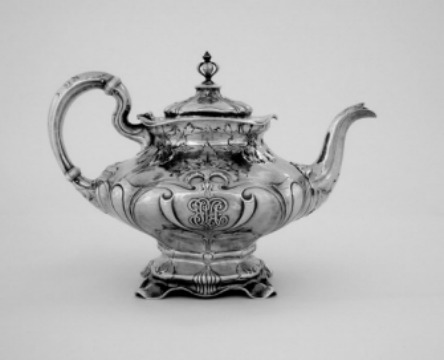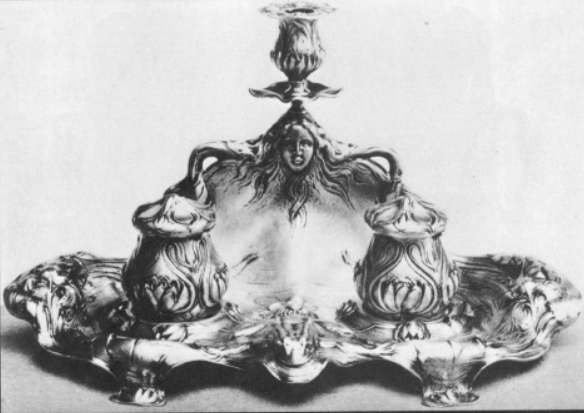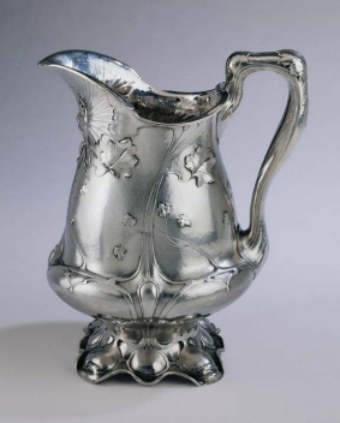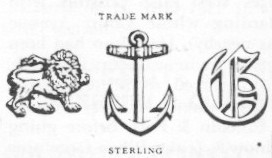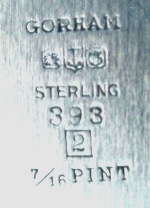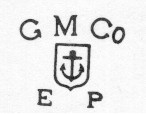click on images to enlarge
GORHAM CORPORATION
Jabez Gorham, founder of Gorham Corporation, was born in Providence,
Rhode Island in 1792 and at 14 began his seven year apprenticeship to
Nehemiah Dodge.
After serving his apprentiship, he formed a partnership with Christopher
Burr, William Hadwen, George C. Clark and Harvey G. Mumford about
1815-1818 at which time he purchased his own shop to manufacture small
items and became known for his "Gorham chain" unequaled at the time.
With Stanton Beebe he made jewelry until 1831 with Henry L. Webster.
The firm name was called Gorham and Webster.
In 1836 the firm was called Gorham, Webster & Price. When Gorham's son,
John joined the firm in 1841, the name was changed to Jabez Gorham &
Son.
John Gorham quickly recognized the advantages of machinery and as a
result the Gorham company was the first to introduce factory methods to
augment hand craftmanship in production of silverware.
In 1850, three years after Jabez Gorham retired, the company name was
Gorham & Thurber. By 1852, it was Gorham & Company.
The firm was chartered by the Rhode Island Legislature as the Gorham
Manufacturing Company in 1863. In 1868 they abandoned the coin silver
standard (900/1000) and adopted the sterling standard of 925/1000.
At this time the famous Gorham trademark (a lion, an anchor and a
capital G) was adopted for use on all the sterling articles.
By 1863, the company started to produce electropated silverwares using
nickel silver as the base. Made entirely of nickel silver, these wares
were processed by the same general methods used in making sterling
silverware, even to the use of silver solder in assembling the component
parts.
The tooling occupied two years, so they started to market their
silverplated wares only in 1865. They ceased production of their
silverplated flatware by May,1, 1962 but their silverplated holloware
continues to be an important part of their output.
The Gorham company has been noted for the fine quality of its die work
as well as superior design and fine finishing of all products.
One of most successful line of products was the the Martele ware. The
metal used in the Martele ware was softer and purer than the sterling
standard (950/1000 parts of silver) and it was hammered in ornamental
shapes that clearly reflect the Art Nouveau Influence.
In 1891 Gorham had brought over from England the talented artist William
J. Codman to direct their design department. He become the guiding
spirit in the development of Martele' ware.
The idea was to develop a line of silverware which should be essentially
an art production. The artisan was given a design and a flat sheet of
metal and told to work it by hand with an hammer and any other tools,
which were necessary for the design in mind.
There are no two pieces alike and even small pieces of Martele' silver
can be quite expensive even today.
The inspiration was Art Nouveau with classic and fantastic figures of
nude female figures, floral and leaf decorations.
A similar type of Gorham silverware called Athenic of the same period
was Grecian in inspiration and used different kind of metals (bronze and
copper over silver).
The main output of the line started from 1900 and declined circa 1920,
but Martelé continued to be produced into the 1930's
There were about 7000 to 8000 pieces made and only 1500-1700 are still
existent.
When the price of the silver went up in the 80's much Martele' silver
was melted down.
Examples of Martele' silverware are shown below:
MARKS FOR GORHAM SILVER
Gorham's familiar trademark was used as early as 1848 and from 1848
to 1865 the lion faced left rather than right.
After 1865, this was the Trademark for sterling silver:
The Athenic Trademark was used in articles that are Art Noveau in
feeling but Greek in inspiration. Sterling silver is often combined with
other materials.
Gorham Martele' Trademark was used for the Martele' silverware line.
Holloware year markings have been used since 1868.
Letters of the alphabet A through Q were used from 1868 through 1884 at
which time symbols were adopted for each year until 1933 at which time
they were discontinued.
A good reference on the symbols used by Gorham for the years between
1884 and 1933 can be found on Encyclopedia of American Silver
Manufacturers by Dorothy Rainwater.
From 1941, the year mark was a number inside a square frame.
For the 1950s, the year mark was a number inside a pentagon frame.
For the 1960s, the year mark was a number inside a hexagon frame.
For the 1970s, the year mark was a number inside a heptagon frame.
For the 1980s, the year mark was a number inside an octagon frame.
Gorham also produced fine silver plated holloware and flatware.
Production of silverplated flatware was stopped in 1962 but silverplated
holloware continues until today.
Following is an example of trademark for silver plated:
Bibliography
- Kovel's American Silver Marks by Ralph and Terry Kovel
- Encyclopedia of American Silver Manufacturers by Dorothy Rainwater
- Interesting Article on Gorham Marks:
http://www.owlbridge.com/gorham_marks.shtml
The complete list of Gorham date code is available on the web in
www.925-1000.com
the very informative website managed by ASCAS member Tom Guarrera.
Gianmarco Baldini - 2004 -
|

